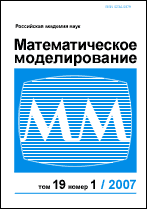|
Modeling of vibration of nanoporous microcantilevers from anodic aluminum oxide for biochemical sensors
V. N. Simonovab, N. L. Matisona, O. V. Boytsovacd, E. B. Markovae
a National Research Nuclear University MEPhI (Moscow Engineering Physics Institute)
b Institute of Physical Chemistry and Electrochemistry of RAS (IFKhE RAN)
c Kurnakov Institute of General and Inorganic Chemistry of RAS
d Lomonosov Moscow State University
e RUDN University (Peoples' Friendship University of Russia)
Abstract:
The results of a study of the oscillations of microcantilevers (MC) made of nanoporous anodic aluminum oxide and constituting the basis of biochemical sensors are described. Finite-element modeling of MC vibrations revealed sources of resonances in the frequency spectrum that do not correspond to the cantilever oscillations and complicate the development of sensors. It has been shown for the first time that such sources are resonances of vibrations of the base of the MC on the elastic layer of the compound used to attach the base to the substrate. Approximate relationships between the parameters of the MC, base, and compound layer are obtained, which ensure that only the working modes of MC vibrations are present in the spectrum. To ensure a clean spectrum, one of two conditions must be observed or a combination of both: a sufficiently rigid MC attachment to the substrate and a sufficiently small base size. Ensuring a clean spectrum is achieved regardless of the rigidity of the MC fastening, if the base length does not exceed: for the 3rd, 4th, and 5th harmonics of the MC working mode — 0.6, 0.43, and 0.33 MC lengths, respectively.
Keywords:
microcantilever, sensor, anodic alumina, vibration modes, resonance, frequency, elastic modulus, porosity, atomic force microscope.
Received: 17.04.2020
Revised: 17.04.2020
Accepted: 15.06.2020
Citation:
V. N. Simonov, N. L. Matison, O. V. Boytsova, E. B. Markova, “Modeling of vibration of nanoporous microcantilevers from anodic aluminum oxide for biochemical sensors”, Matem. Mod., 32:8 (2020), 31–42; Math. Models Comput. Simul., 13:2 (2021), 293–300
Linking options:
https://www.mathnet.ru/eng/mm4204 https://www.mathnet.ru/eng/mm/v32/i8/p31
|

| Statistics & downloads: |
| Abstract page: | 312 | | Full-text PDF : | 76 | | References: | 38 | | First page: | 10 |
|




 Contact us:
Contact us: Terms of Use
Terms of Use
 Registration to the website
Registration to the website Logotypes
Logotypes








 Citation in format
Citation in format 